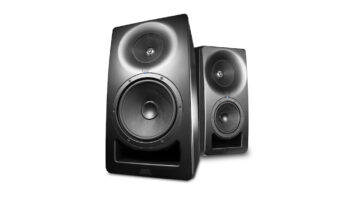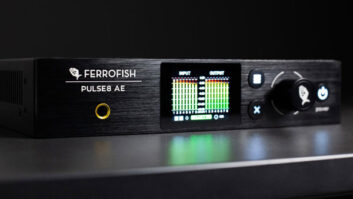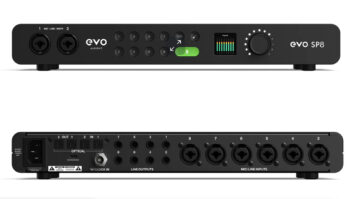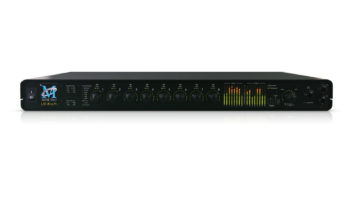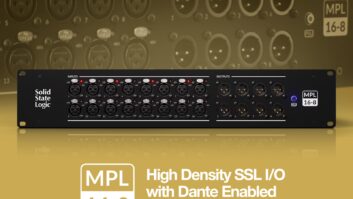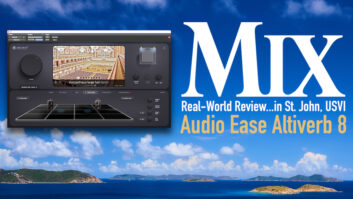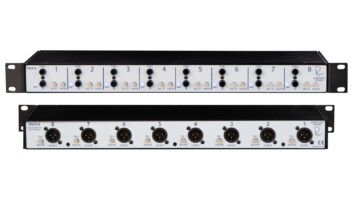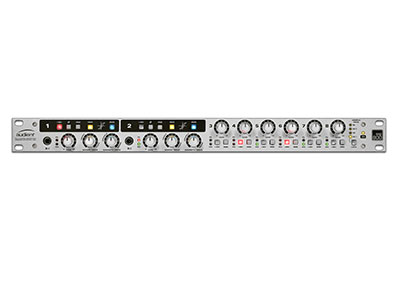
Here in the States, Audient doesn’t seem to receive the same amount of attention as other British imports, and it’s odd because the company’s forward-thinking product designs seem to align perfectly with the needs of modern engineers who want to work “in the box” without relinquishing the conveniences of classic console-based control rooms.
The company’s new mic preamp, the 8-channel ASP800, builds off of the design of the company’s retired ASP008, in packaging its ASP8024 console’s mic preamps into a stand-alone box. The new ASP800, however, has a few extra tricks up its sleeve to produce some unique tones that evoke the sounds of vintage consoles.
The ASP800 packs a good amount of firepower into a slick and compact single-rackspace unit featuring eight total inputs, each capable of receiving mic or line inputs, with channels 1 and 2 also offering optional JFET DIs. The line-level product of each of these amplifiers can be outputted as an analog signal, or A/D converted inside the unit and fed to an interface or console through optical ADAT connectivity. The ASP800 relies on Burr-Brown converters for its ADC.
The rear panel features eight Neutrik XLR/TRS combo jacks that feed the amplifier inputs at mic or line level. To the left of that is a pair of Toslink connectors. A single connector can be used for ADAT optical connections up to 48 kHz, or the pair can be used to split the eight channels when using SMUX, available at rates up to 96 kHz. The unit can clock internally and feed its clocking signal to a host directly. Alternatively, the ASP800’s dedicated BNC wordclock input can be used to clock to the host or a master wordclock generator. Analog outputs are also provided using a single DB-25 connector.
Of the eight preamps provided, channels 3 through 8 use a circuit that is said to be identical to the mic preamp found in all of Audient’s full consoles. This preamp has a clean, snappy sound that is full and detailed but doesn’t impose itself. It is a great tool for accurate capture, leaving room for coloration in the mix. Each channel has a sturdy-feeling gain knob with a comfortable, smooth-cornered, continuously variable knob. Each preamp has a backlit phantom power button and -15 dB pad. Metering is provided as a simple “signal present” and peak indicator.
The first two channels of the ASP800 feature advanced tone-shaping functions with two different “color” circuits in each signal path providing the ability to add harmonic saturation and alter the overall character of the recording.
The HMX effect is a MOSFET circuit designed to emulate the characteristics of tube-based saturation. The IRON effect uses a custom-built transformer to impart vintage British console-like tones with great authenticity. Each function has a button to engage or disengage the effect and a single knob to control its value. With no numerical values, the HMX control ranges from “Sweet” to “Thick” and the IRON ranges from “Sparkle” to “Growl.”
One of the first recordings I did with the ASP800 was a combo guitar amp close miked with a ribbon mic. The first tone that the guitarist dialed in was a blistering distorted sound with a chattering delay. In the room, it sounded ferocious, and the ribbon mic did a good job of capturing the aggression without being too edgy. I also wanted the low end that ribbon mics usually provide when close miking an amp because the amp seemed to be coming up just a little short in that department.
I tried a few different pre’s that all provided a fairly accurate depiction of the amp. Eventually, I landed on the ASP800. Its stock preamp sound, like the others, seemed true enough. Then I engaged the HMX control, and as I turned it up, I was pleasantly surprised to find the bottom end filling in. By the time I had turned the control to around 1 o’clock, any significant change seemed to stop. The effect, even at that point seemed fairly subtle. In an A-B comparison with the circuit in or out, however, the improvement was clear and pronounced.
When I added in the IRON effect, the guitar started coming more and more into focus, with all of the grit and edge and chatter of the delays starting to crisp up. The control’s effect was relatively minimal to start with, but started coming into its own at around 2 o’clock and became more pronounced after that. As with the HMX, I had to listen very carefully to hear if the IRON was even working at all. At times I wasn’t sure whether it was the performance that was changing or the character imparted by the preamp. Once again, when I compared both circuits in and out, the difference seemed immense. This speaks to the fact the effects are very natural and complement the signal without being overbearing. Altogether, the two seasonings working in tandem woke up the guitar amp and greatly improved the recording.
Early on I noticed that the preamp seemed to distort very easily, even when my DAW meters indicated that there was plenty of headroom. I had been using the ASP800’s digital output to feed signal to my DAW. I realized that there was a button on the back that could toggle the ADC’s 0dBFS point between +12dBu and +18dBu, for compatibility with different interfaces. When switching the control +18dBu, the headroom opened up, and the problem seemed to be solved. However, in either case, when a clip did occur, the sound was pretty brutal and jarring in the headphones. Most modern A/D converters backstop their analog component with some sort of safety limiter so that subtle overs might still pass a usable signal. That did not seem to be the case here.
Using the ASP800 as a DI, I came up with some great sounds. On a clean electric guitar, the DI circuit produced a thick, substantial sound and sparkled nicely in the upper midrange. The IRON circuit did a nice job of clarifying the pick attack and making the guitar pop in the track. On a DI’d bass, once again, the basic sound was full and clear. Stirring in the HMX circuit made the bottom swell more and more as I boosted the control. As the bass grew fuller, it never really got muddy. It seemed like just the right frequencies were becoming more pronounced. The IRON control didn’t do much in this case.
Particularly when recording bass, I found myself wishing that the preamp had an output level control. I’ve been a fan of the kind of tones that preamps like the Universal Audio 710 Twinfinity have produced when overdriving the tubes and transformers, and then backing off the output to avoid clipping A/D converters. With the APS800, this type of full-on saturation was never possible. Sometimes I could get close by cranking up the IRON control, but just as I would approach that sound by gaining up the input, a loud note would violently clip the A/D converter.
On snare drum, the HMX and IRON worked together to make it pop. I miked the drum with an SM57, and using the IRON control was almost like using an exciter. It created all of this brilliance and made the misty splash of the snares more pronounced. The HMX gave me the option to selectively bring the shell into the forefront. On a D112 inside a kick drum, a slight twist of the HMX started to fatten the bottom, but it didn’t take much to turn it muddy. I expected the IRON control to help clarify the beater, but it also seemed a little too thick and wound up bringing out too much of the low midrange. Maybe it was the mic or the drum, but I wasn’t feeling the magic as much in that case.
Because the ASP800 has line inputs, I also used it on a couple of mixes. I particularly liked what it did to drum overheads. Here, with the HMX control cranked to 3 o’clock, I heard the circuit’s typical thickening of the bottom end. At the same time, it brought an interesting definition to the hi-hat. Especially in busier sections where the hats were opened up, the HMX circuit seemed almost like an expander, boosting the volume of the quieter parts of their envelope. Dialing in a light setting on the IRON control, everything tightened up as clutter seemed to disappear, and all of the attacks became more pronounced.
It was a lot of fun finding new and interesting sounds with the ASP800. If you have an interface with no mic preamps, like the Avid HD I/O, or are looking to use your eight additional optical inputs of an interface, this seems like a very sensible option at $100 per channel. The basic mic pre is solid all-around, and the HMX and IRON effect can add some richness to your recordings. On top of that, it’s always nice to find tracking gear that can double as mixing gear, and that is certainly the case with the first two channels of the ASP800.
Brandon Hickey is an Arizona-based independent recording and film sound engineer.
Product Summary
COMPANY: Audient
PRODUCT: ASP800
WEBSITE:www.audient.com
PRICE: $799 (street)
PROS: Lots of sonic options, good-sounding converters.
CONS: No insert or output control on mic preamps.
